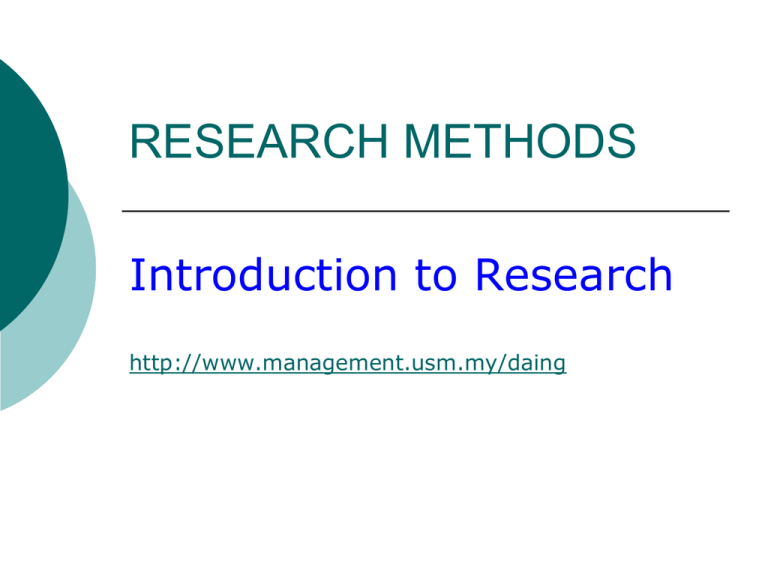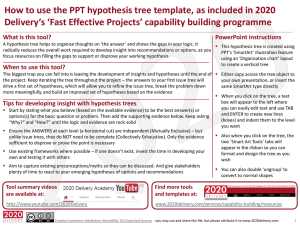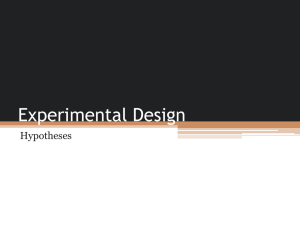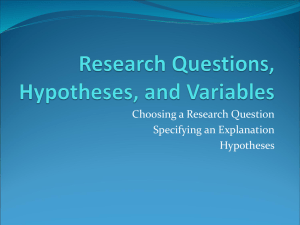RESEARCH METHODS
advertisement

RESEARCH METHODS Introduction to Research http://www.management.usm.my/daing What is Research? Definition: An organised, systematic, databased critical scientific inquiry or investigation into a specific problem, undertaken with the objective of finding answers or solutions to it. Outcome: Information that enables managers to make decisions to rectify problems. Data : Primary (first-hand) or Secondary (readily available); Quantitative or Qualitative What is Research? Research. a. the systematic investigation into and study of materials, sources, etc, in order to establish facts and reach new conclusions. b. an endeavour to discover new or collate old facts etc by the scientific study of a subject or by a course of critical investigation. [Oxford Concise Dictionary] 3 What is Research? Research is what we do when we have a question or a problem we want to resolve We may already think we know the answer to our question We may think the answer is obvious, common sense even But until we have subjected our problem to rigorous scientific scrutiny, our 'knowledge' remains little more than guesswork or at best, intuition. 4 What is research? First priority is to formulate your question Then figure out how you are going to answer it How have others answered it? How does your proposal fit in with what others have done? How will you know when you have answered it? Then you can present your answer 5 Research Workflow Defines the step by step flow for your research Keeps you organized 6 Research Workflow OBSERVATION Broad area of research interest identified PROBLEM DEFINITION THEORETICAL FRAMEWORK Research problem delineated Variables clearly identified and labeled HYPOTHESES GENERATION SCIENTIFIC RESEARCH DESIGN PRELIMINARY DATA GATHERING Interviewing & Literature Survey DEDUCTION Hypotheses substantiated? Research questions answered DATA COLLECTION, ANALYSIS AND INTERPRETATION Finding Research Problem – (Where and How) Literature review Library websites Class discussions Discussion with your professors and peers 8 Defining Problem Statement Highway Capacity Manual (HCM) presents a methodology for traffic analysis on urban streets Weaknesses of HCM methodology for urban street; Default values for basic speeds not well substantiated by data. Does not consider traffic flow influencing running speeds of vehicles. HCM underestimates travel speed. A number of studies have been performed for traffic delays at intersection along urban streets. 9 Formulating Hypothesis Running Speeds of vehicles are affected by traffic volume Roundabouts can be used as an effective tool for traffic calming Vehicle speeds are positively correlated with speed limit Both the bodies and brains of men and women differ in many aspects 10 What is Hypotheses? A HYPOTHESIS is a prediction of a relationship between one or more factors and the problem under study that can be tested. Hypotheses can take various forms, depending on the question being asked and the type of study being conducted. A key feature of all hypotheses is that each must make a prediction. These predictions are then tested by gathering and analyzing data, and the hypotheses can either be supported or refuted on the basis of the data. Characteristics of hypotheses Declarative statement that identifies the predicted relationship between 2 or more variables Testability Based on sound scientific theory/rationale Two types of hypotheses with which you should be familiar are the null hypothesis and the alternate (or experimental) hypothesis. The null hypothesis always predicts that there will be no differences between the groups being studied. By contrast, the alternate hypothesis predicts that there will be a difference between the groups. For example, the null hypothesis would predict that the exercise group and the no-exercise group will not differ significantly on levels of cholesterol. The alternate hypothesis would predict that the two groups will differ significantly on cholesterol levels. Directional vs. Non-Directional Hypotheses Directional hypothesis Specifies the direction of the relationship between independent and dependent variables Non-directional hypothesis Shows the existence of a relationship between variables but no direction is specified Examples Directional hypothesis Cardiac patients who receive support from former patients have less anxiety and higher self-efficacy than other patients Non-directional hypothesis There is a difference in anxiety and self-efficacy between cardiac patients who receive support from former patients and those who do not Research vs. Statistical Hypotheses Research hypothesis = scientific hypothesis Statement about the expected relationship of the variables Can be directional or nondirectional Statistical hypothesis = null hypothesis States there is no relationship between the variables Example: Statistical Hypothesis Oxygen inhalation by nasal cannula of up to 6L/min does not affect oral temperature measurement taken with an electronic thermometer. Research Objectives What do you want to achieve from your research State your objectives in clear and concise manner. 18 Research Objectives Determine the factors affecting running speed of vehicles on urban streets. Analyze the impacts of those factors. Model the influence of the factors affecting running speed. 19 TYPES 1. 2. General objective: states what researchers expect to achieve by the study in general terms. Specific objectives: smaller, logically connected parts of general objective. They are the specific aspects of the topic that we want to study within the framework of our study Specific objectives should systematically address the various aspects of the problem. They should specify what we will do in our study, where and for what purpose. Example To explore to what extent community home-based care (CHBC) projects provide adequate, affordable and sustainable care of good quality to people with HIV/AIDS, and to identify ways in which these services can be improved. It was split up in the following specific objectives: 1. To identify the full range of economic, psychosocial, health/nursing care and other needs of patients and their families affected by AIDS. 2. To determine the extent to which formal and informal support systems address these needs from the viewpoint of service providers as well as patients. 3. To determine the economic costs of CHBC to the patient and family as well as to the formal CHBC programmes themselves. 4. To determine how improved CHBC and informal support networks can contribute to the needs of persons with AIDS and other chronically and terminally ill patients. 5. To use the findings to make recommendations on the improvement of CHBC to home care providers, donors and other concerned organizations, including government. Why should research objectives be developed? To Focus the study (narrowing it down to essentials); To Avoid the collection of data which are not strictly necessary for understanding and solving the problem we have identified; and To Organize the study in clearly defined parts or phases. Properly formulated, specific objectives will facilitate the development of our research methodology and will help to orient the collection, analysis, interpretation and utilization of data. Take care that the objectives of your study: Cover the different aspects of the problem and its contributing factors in a coherent way and in a logical sequence; Are clearly phrased in operational terms, specifying exactly what you are going to do, where, and for what purpose; Are realistic considering local conditions; and Use action verbs that are specific enough to be evaluated. Examples of action verbs are: to determine, to compare, to verify, to calculate, to describe, and to establish. Avoid the use of vague nonaction verbs such as: to appreciate, to understand, or to study. Research Methods: The ways in which research studies are designed and the procedures by which data are analysed Survey Methodology: Research conducted by collecting data and analysing them to come up with answers to various issues of interest to us. https://docs.google.com/viewer?a= v&pid=sites&srcid=YWFnLm9yZ3xte WNvZS1zZXJ2aXJnbG9iYWx8Z3g6O DBmYmY0NTYzMzVmMTEw 2012 Application Form.doc http://www.writing.engr.psu.edu/w orkbooks/proposal.samples.html References http://www.shoreline.edu/eng102/sampt hesis.htm www.newagepublishers.com/samplechap ter/000896.pdf (Research Methodology An Introduction) http://blogs.lse.ac.uk/impactofsocialscie nces/2011/06/20/essential-guidewriting-good-abstracts/ Ranjit Kumar (Research Methodology- A Step by Step guide for Beginners) 28








